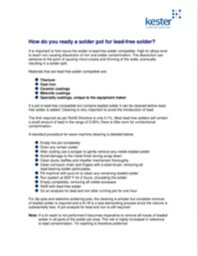How do you ready a solder pot for lead-free solder?
It is important to first insure the solder is lead-free solder compatible. High tin alloys tend to leach iron causing dissolution of iron and solder contamination. The dissolution can advance to the point of causing micro-cracks and thinning of the walls, eventually resulting in a solder spill.
If a pot is lead-free compatible but contains leaded solder it can be cleaned before leadfree solder is added.
Download this whitepaper to learn more.
Read More
By submitting this form you agree to Kester Inc contacting you with marketing-related emails or by telephone. You may unsubscribe at any time. Kester Inc web sites and communications are subject to their Privacy Notice.
By requesting this resource you agree to our terms of use. All data is protected by our Privacy Notice. If you have any further questions please email dataprotection@techpublishhub.com
Related Categories: cooling


More resources from Kester Inc

Lead-free Wave Soldering
As lead-free gains momentum, many engineers are striving to set-up a wave solder process that maintains production yields but also offer reliable a...

THE NATURE OF WHITE RESIDUE ON PRINTED CIRCUIT ASSEMBLIES
White residue remaining after cleaning circuit board assemblies can be caused by a variety of chemicals and reactions. Rosin and water-soluble flux...

Case Study on the Validation of SAC305 and SnCu Based Solders in SMT, Wave and Hand-soldering at the Contract Assembler Level
In recent years tin-copper based solders with a variety of elemental additives have emerged which improve the overall properties and performance of...
